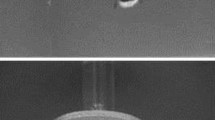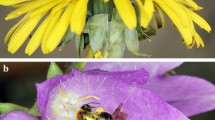Abstract
Several recent hypotheses, including sensory drive and sensory exploitation, suggest that receiver biases may drive selection of biological signals in the context of sexual selection. Here we suggest that a similar mechanism may have led to convergence of patterns in flowers, stingless bee nest entrances, and pitchers of insectivorous plants. A survey of these non-related visual stimuli shows that they share features such as stripes, dark centre, and peripheral dots. Next, we experimentally show that in stingless bees the close-up approach to a flower is guided by dark centre preference. Moreover, in the approach towards their nest entrance, they have a spontaneous preference for entrance patterns containing a dark centre and disrupted ornamentation. Together with existing empirical evidence on the honeybee's and other insects’ orientation to flowers, this suggests that the signal receivers of the natural patterns we examined, mainly Hymenoptera, have spontaneous preferences for radiating stripes, dark centres, and peripheral dots. These receiver biases may have evolved in other behavioural contexts in the ancestors of Hymenoptera, but our findings suggest that they have triggered the convergent evolution of visual stimuli in floral guides, stingless bee nest entrances, and insectivorous pitchers.


Similar content being viewed by others
References
Albert VA, Williams SE, Chase MW (1992) Carnivorous plants: phylogeny and structural evolution. Science 257:1491–1495
Backhaus W (1991) Colour opponent coding in the visual system of the honeybee. Vision Res 31:1381–1397
Biesmeijer JC, Tóth E (1998) Individual foraging, activity level and longevity in the stingless bee Melipona beecheii in Costa Rica (Hymenoptera, Apidae, Meliponinae). Ins Soc 45:427–443
Blamey M, Grey-Wilson C (1993) Mediterranean wild flowers. Harper Collins Publishers, Jersey
Briscoe AD, Chittka L (2001) The evolution of color vision in insects. Annu Rev Entomol 46:471–510
Chittka L (1996) Does bee colour vision predate the evolution of flower colour? Naturwissenschaften 83:136–138
Chittka L, Thomson JD, Waser NM (1999) Flower constancy, insect psychology, and plant evolution. Naturwissenschaften 86:361-377
Chittka L, Schorn J, de Souza JM, Ventura DF, Camargo JMF (1997) The nest entrance signal of the Amazonian bees Partamona pearsoni—a case where insects design their own flight targets. In: Kipyatkov VE (ed) Proceedings of the International Colloquia on Social Insects, Russian Language Section of the IUSSI, St. Petersburg, vol. 3–4, pp. 107–116
Crepet WL, Friis EM (1987) The evolution of insect pollination in angiosperms. In: Friis EM, Chaloner WG, Crane PR (eds) The origins of angiosperms and their biological consequences. Cambridge University Press, Cambridge, pp 181–201
Dafni A, Giurfa M (1999) The functional ecology of floral guides in relation to insects behaviour and vision. In: Wasser SP (ed) Evolutionary theory and processes: modern perspectives. Kluwer Academic Publishers, Leiden, pp 363–383
Dafni A, Giurfa M, Menzel R (eds) (1997a) Special issue: insect vision and flower recognition. Isr J Plant Sci 45(2–3)
Dafni A, Lehrer M, Kevan PG (1997b) Spatial flower parameters and insect spatial vision. Biol Rev 72:239–282
Darwin C (1875) Insectivorous plants. Murray, London
Darwin C (1876) The effects of cross- and self-fertilization in the vegetable kingdom. Murray, London
Daumer K (1956) Reizmetrische Untersuching des Farbensehens der Bienen. Z vergl Physiol 38:413–478
Daumer K (1958) Blumenfarben, wie sie die Bienen sehen. Z vergl Physiol 41:49–110
Dawkins MS, Guilford T (1997) Conspicuousness and diversity in animal signals. In: Owings et al (eds) Perspectives in ethology, vol 12. Plenum Press, New York, pp 55–75
Ellison AM, Gotelli NJ (2001) Evolutionary ecology of carnivorous plants. TREE 16:623–629
Endler JA (1992) Signals, signal conditions, and the direction of evolution. Am Nat 139(Suppl) S125–S153
Endler JA, Basolo AL (1998) Sensory ecology, receiver biases and sexual selection. TREE 13:415–420
Evans HE (1957) Studies on the comparative ethology of digger wasps of the genus Bembix. Comstock Publ Assoc, Ithaca NY
Faegri K, van der Pijl L (1979) Principles of pollination ecology. Pergamon Press, Oxford
Fitter R, Fitter A, Blamey M (1974) The wild flowers of Britain and Northern Europe. Collins, London
Giurfa M, Menzel R (1997) Insect visual perception: complex abilities of simple nervous systems. Curr Opin Neurobiol 7:505–513
Giurfa M, Lehrer M (2001) Honeybee vision and floral displays: from detection to close-up recognition. In: Chittka L, Thomson JD (eds) Cognitive ecology of pollination. Cambridge University Press, Cambridge, pp 61–82
Giurfa M, Nuñez J, Chittka L, Menzel R (1995) Colour choice of flower-naïve honeybees. J Comp Physiol A 177:247–259
Giurfa M, Eichmann B, Menzel R (1996) Symmetry perception in an insect. Nature 382:458–461
Guilford T, Dawkins MS (1991) Receiver psychology and the evolution of animal signals. Anim Beh 42:1–14
Guilford T, Dawkins MS (1993) Receiver psychology and the design of animal signals. TINS 16:430–436
Hertz M (1930) Die Organisation des optischen Feldes bei der Biene. Z vergl Physiol 11:107–145
Horridge A (1994) Bee vision of pattern and 3D. Bioessays 16:877–884
Jaffé K, Michelangeli F, Gonzalez JM, Miras B, Ruiz MC (1992) Carnivory in pitcher plants of the genus Heliamphora (Sarraceniaceae). New Phytol 122:733–744
Joel DM (1988) Mimicry and mutualism in carnivorous pitcher plants (Sarraceniaceae, Nepenthaceae, Cephalotaceae, Bromeliaceae). Biol J Linn Soc 35:185–197
Joel DM, Juniper BE, Dafni A (1985) Ultraviolet paterns in the traps of carnivorous plants. New Phytol 101:585–593
Juniper BE, Robins RJ, Joel DM (1989) The carnivorous plants. Academic Press, London
Kidd MM (1983) Cape Peninsula. Kirstenbosch, Claremont
Lehrer M, Horridge GA, Zhang SW, Gadagkar R (1995) Shape vision in bees: innate preferences for flower-like patterns. Philos Trans R Soc Lond Ser B 347:123–137
Lunau K (1990) Color saturation triggers innate reactions to flower signals – flower dummy experiments with bumblebees. J Comp Physiol A 166(6): 827–834
Lunau K (1992) A new interpretation of flower guide colouration: absorption of ultraviolet light enhances colour saturation. Plant Syst Evol 183:51–65
Menzel R (1979) Spectral sensitivity and colour vision in invertebrates. In: Autrum H (ed) Handbook of sensory physiology, vol VII/6a. Springer, Berlin Heidelberg New York, pp 504–580
Menzel R, Shmida A (1993) The ecology of flower colours and the natural colour vision of insect pollinators: the Israeli flora as a case study. Biol Rev 68:81–120
Moran JA (1996) Pitcher dimorphism, prey composition and the mechanisms of prey attraction in the pitcher plant Nepenthes rafflesiana in Borneo. J Ecol 84:515–525
Moran JA, Booth WE, Charles JK (1999) Aspects of pitcher morphology and spectral characteristics of six Bornean Nepenthes pitcher plant species: implications for prey capture. Ann Bot 83:521–528
Proctor M (1996) The natural history of pollination. Timber Press, Portland
Rodriguez I, Gumbert A, Hempel de Ibarra N, Kunze J, Giurfa M (2004) Symmetry is in the eye of the beeholder: innate preference for bilateral symmetry in flower-naive bumblebees. Naturwissenschaften 91:374–377
Roubik DW (1979) Nest and colony characteristics of stingless bees from French Guiana (Hymenoptera: Apidae). J Kansas Entomol Soc 52:443–470
Roubik DW (1983) Nest and colony characteristics of stingless bees from Panama (Hymenoptera: Apidae). J Kansas Entomol Soc 56:327–355
Ryan MJ (1998) Sexual selection, receiver biases, and the evolution of sex differences. Science 281:1999–2003
Scotter WG, Flygare H (1986) wildflowers of the Canadian rockies. Hurting Publishers, Toronto
Slack A (1980) Carnivorous plants. Alphabooks, London
Sprengel CK (1793) Das entdeckte Geheimniss der Natur in Bau und in der Befruchtung der Blumen. Friedrich Vieweg der Ältere, Berlin
Srinivasan MV, Zhang SW, Rolfe B (1993) Is pattern vision in insects mediated by ‘cortical’ processing? Nature 362:539–540
Tinbergen N (1972) The animal in its world: I. Field studies. Harvard University Press, Cambridge MA
von Frisch K (1914) Der Farbensinn und Formensinn der Bienen. Zool Jb (Physiol) 35:1–188
Vorobyev M, Gumbert A, Kunze J, Giurfa M, Menzel R (1997) Flowers through the insect eyes. Isr J Plant Sci 45:93–101
Wehner R (1972) Dorsoventral asymmetry in the visual field of the honey bee, Apis mellifera. J Comp Physiol 77:256–277
Wehner R (1981) Spatial vision in arthropods. In: Autrum H (ed) Handbook of sensory physiology, vol. VII-6C. Springer, Berlin Heidelberg New York, pp 287–616
Wille A, Michener CD (1973) The nest architecture of stingless bees with special reference to those of Costa Rica. Rev Biol Trop 21(Suppl):1
Acknowledgements
We thank V. L. Imperatriz-Fonseca (USP, São Paulo) and Arbofilia (El Sur de Turrubares, Costa Rica) for their hospitality and for allowing us to work with their bees and T. Seeley, D. Tarpy, P. Slater, J. Tomkins and three anonymous referees for critical comments on the manuscript. The work was supported by WOTRO, the Netherlands Foundation for the advancement of Science (JCB) and FAPESP (DK)
Author information
Authors and Affiliations
Corresponding author
Rights and permissions
About this article
Cite this article
Biesmeijer, J.C., Giurfa, M., Koedam, D. et al. Convergent evolution: floral guides, stingless bee nest entrances, and insectivorous pitchers. Naturwissenschaften 92, 444–450 (2005). https://doi.org/10.1007/s00114-005-0017-6
Received:
Accepted:
Published:
Issue Date:
DOI: https://doi.org/10.1007/s00114-005-0017-6




